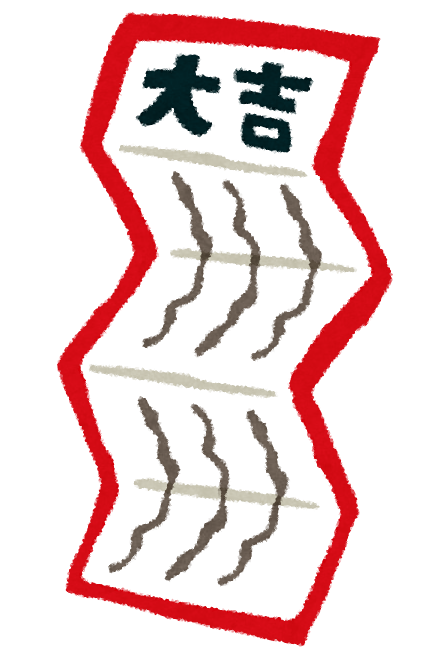
There are many temples and shrines in Japan.
Many Japanese people visit them, especially at New Year, to wish themselves good luck.
In tourist areas, many worshippers also visit them outside the New Year.
Many try OMIKUJI after they finish the prayer.
Omikuji is one of the traditional forms of fortune telling in Japan. It is usually practiced at shrines and temples. Omikuji is a way to learn about one’s destiny and a prediction of the future, and many people look forward to it.
To draw an omikuji, you must first go to a place in a shrine or temple where omikuji is available. There, you may have to pay a certain fee or put money in a box. Usually, it costs between 100 and 300 yen to draw an omikuji. Then you get a small paper strip from the box or container provided.
The paper strip, also called an omikuji, is usually printed with characters or information. Each character represents a particular fortune or message. “Daikichi,” for example, means “the greatest luck” and represents good fortune and success. “Kyo,” on the other hand, represents bad luck or trouble and urges caution.
After you draw an omikuji, you can read its contents to learn its meaning. Omikuji may contain advice or prophecies related to good luck, health, love, and work.
Even if you are not satisfied with the result of your omikuji, there is no need to worry. The omikuji is just an indication, and you can change your future through your actions and efforts. If you receive an omikuji that indicates bad luck, you can tie it to a string connected to the omikuji stand at the shrine or temple. The shrine priests or temple monks will take care of it appropriately so that you will be protected from bad luck. However, remember to heed the message and be careful in your actions.
Here are some words frequently found in Omikuji:
大吉 Daikichi (Great Blessing): The best of luck.
吉 Kichi (Good Luck): A favorable good fortune.
中吉 Chukichi (Medium luck): Your luck may improve depending on your efforts.
小吉 Shokichi (Little luck): Neither good nor bad luck.
末吉 Suekichi (Future luck): Look to the future.
凶 Kyo (Misfortune): There may be trouble or misfortune. Be careful.
I studied Shinto at a university specializing in that field, and worked as a miko (shrine maiden) at a large shrine in Nagoya. During that time, I also sold omikuji, and they were very popular. The faces of the visitors were always cheerful, and they seemed very happy.
Although omikuji is widely accepted as part of Japanese culture and beliefs, it is also a pleasure for foreigners. If you have the opportunity to visit Japan, I highly recommend the Omikuji experience. You will be able to enjoy the anticipation of your happiness and future. Usually, the Omikuji is only in Japanese, so it is helpful to have a guide or someone who speaks Japanese to explain it to you. Recently, some temples, such as Senso-ji Temple in Asakusa, have started offering omikuji in English.












